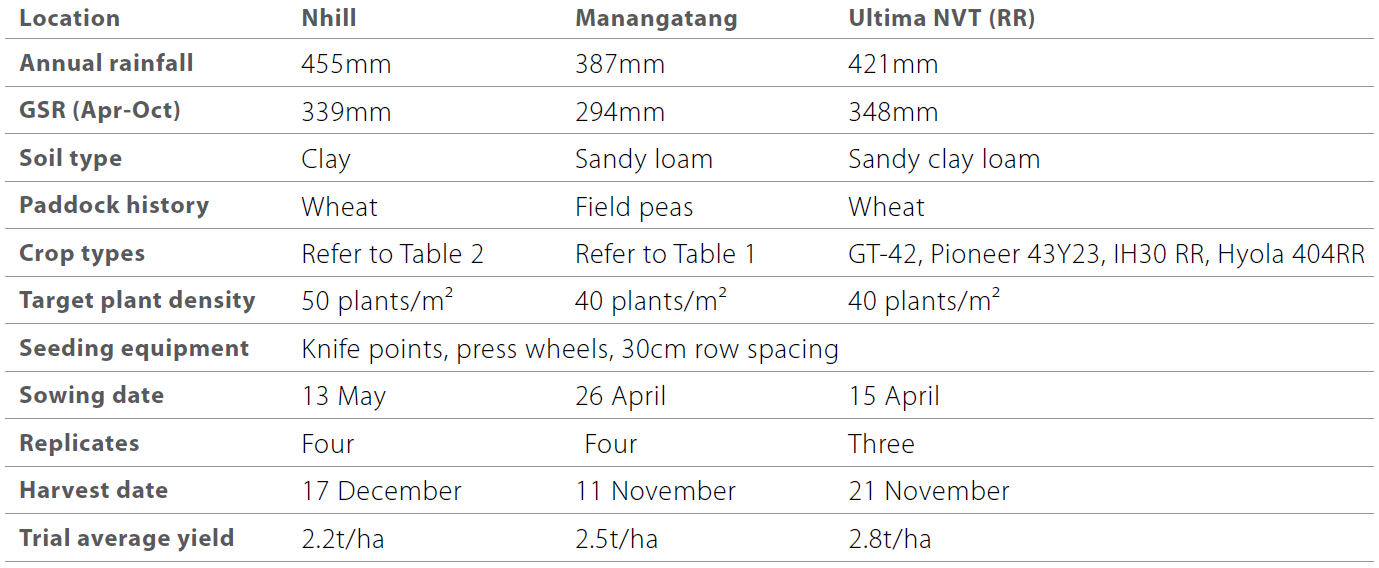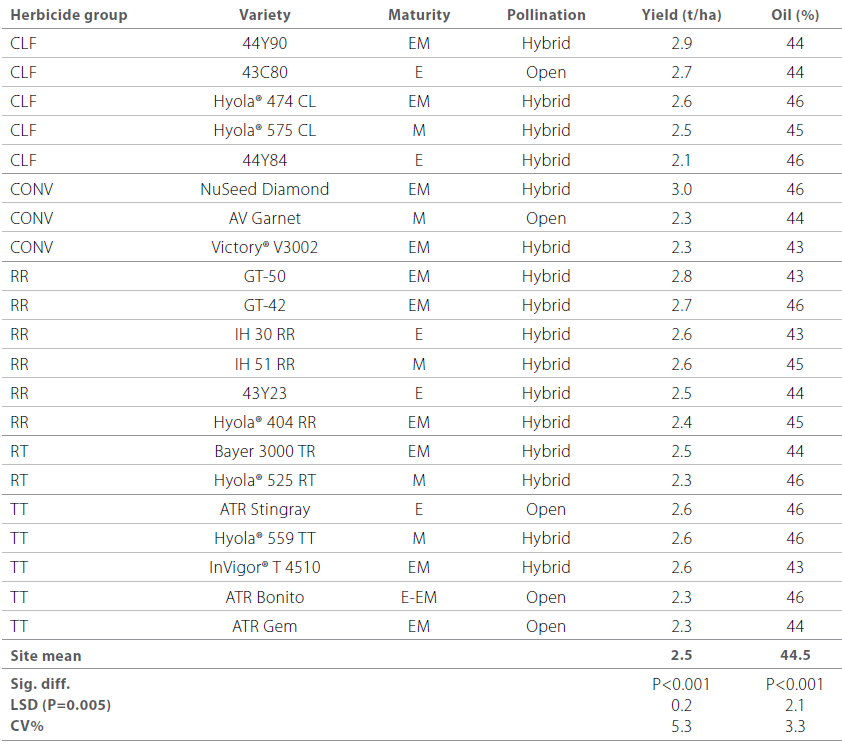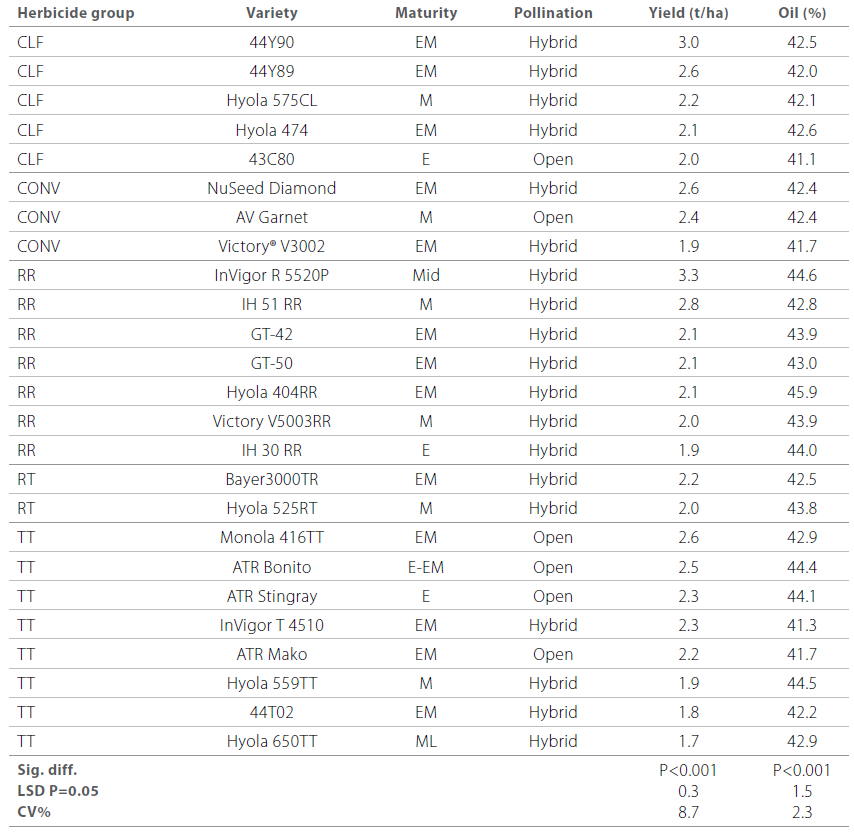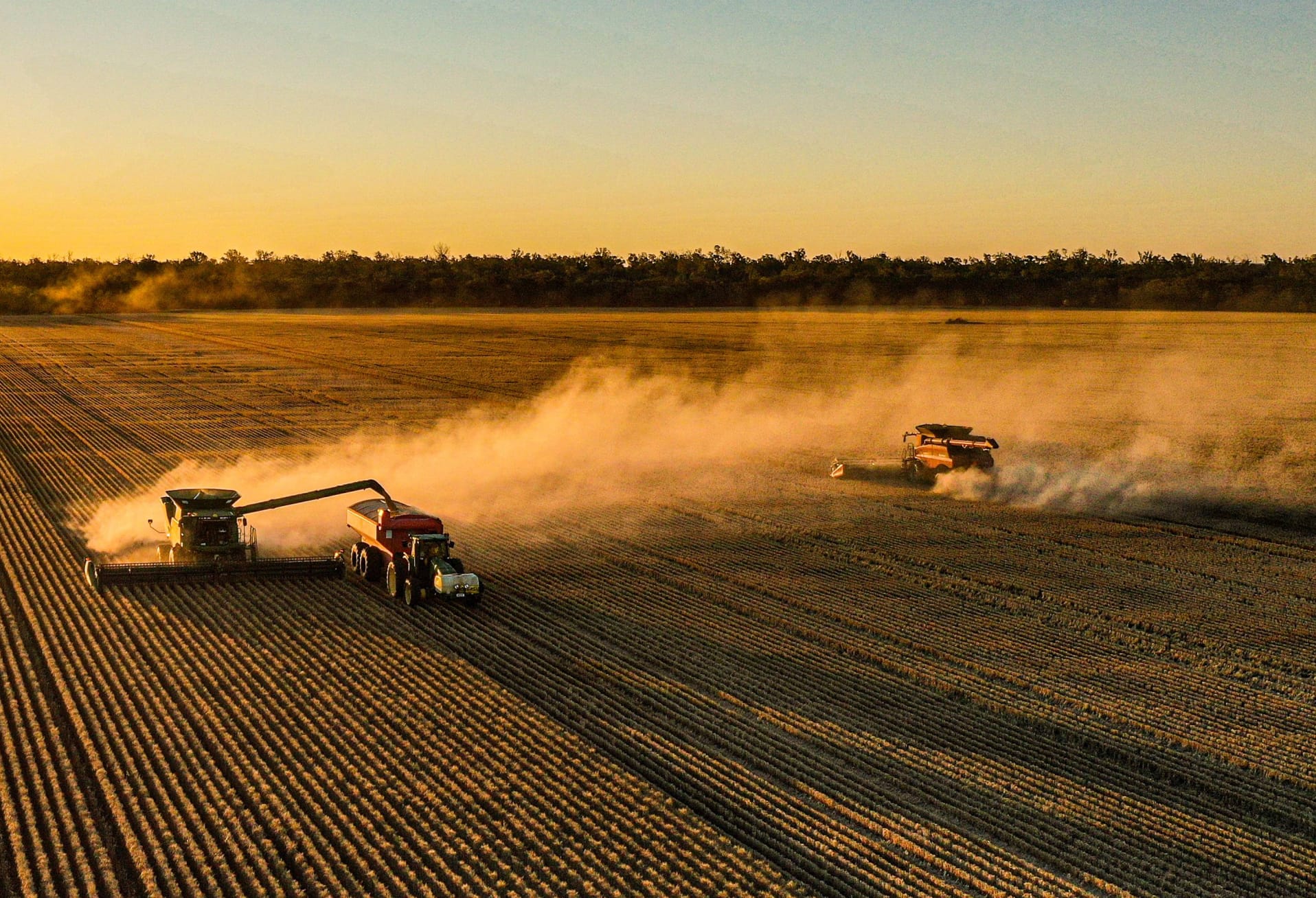Take home messages
- Canola offers great versatility for weed control and where residual herbicides are problematic, despite its inherent production risk.
- NuSeed Diamond (CONV), 44Y90 (CLF), Stingray (TT) and GT-50 (RR) achieved the highest yields in their respective herbicide groups at Manangatang.
- 44Y90, NuSeed Diamond, InVigor® R 5520P (RR) and Bayer 3000TR (RT) achieved the highest yields in their respective herbicide groups at Nhill. The PodGaurd® trait proved beneficial at harvest time.
Background
Growers who persisted with canola in 2016 were rewarded with excellent yields and quality. Those who didn’t, will be tempted to revisit canola in 2017, especially in light of the current cereal prices.
However, while many growers were encouraged by the performance of canola in 2016, and optimistic about its profitability in 2017, it is still a risky crop so soil moisture will be a key determinant come sowing.
Over the past three to four years, canola has truly been pushed to its limits with consecutive dry seasons, frost events and infestations of Green Peach aphids and Diamond Back moths. In 2016, there was little to no issues that affected canola, despite greater incidences of aphids (mainly in cereals).
With significant advances in canola technology over the last ten years, and with the introduction of different herbicide tolerances, hybrid technology and pod shattering technology, growers now have more choice than ever before.
Although canola is not a new crop to the Wimmera and Mallee, varieties change rapidly (with some lines being discontinued) and it is important to investigate newer varieties prior to deciding which to grow.
Aim
To independently assess the performance of existing and emerging canola varieties in the Wimmera and Mallee region.
Trial details and inputs

| Fertiliser Nhill: | Granulock Supreme Z + Impact @ 50kg/ha at sowing, SOA @ 50kg/ha applied at 3-4 leaf, urea @ 80kg/ha applied at 3-4 leaf, urea @ 100kg/ha applied at 6-7 leaf |
| Fertiliser Manangatang: | Granulock Supreme Z + Impact @ 60kg/ha at sowing, SOA @ 50kg/ha at 2 leaf, urea @ 60kg/ha at 5 leaf and urea @ 50kg/ha at flowering |
Weeds were controlled according to their herbicide group. Pests and disease were controlled according to best management practice.
Method
Replicated field trials were sown at Nhill in the Wimmera and Manangatang in the Mallee. A replicated field trial was also sown at Ultima through the GRDC NVT program. At both sites the canola varieties were blocked according to their herbicide group. In-season assessments included emergence scores, NDVI measurements, grain yield and quality. The trial was desiccated prior to harvest; the timing determined by a standard variety within each trial.
Results and interpretation
Manangatang
The Manangatang paddock was ideal for canola with 118mm of plant available water (PAW) and 104kg N/ha. In January the paddock received 104mm of rainfall however, the trial was dry sown.
Conditions at this site were conducive to excellent germination and growth with 8mm of rain five days after sowing followed by 12mm eight days later.
The favourable conditions throughout the season resulted in excellent yields with the top performing Clearfield, Conventional and Roundup Ready® varieties yielding equal to each other; 3t/ha, 2.9t/ha and 2.8t/ha respectively.
The site had an average oil content of 44.5 per cent (ranging between 43 and 46 per cent).
Roundup Triazine (RT) canola is relatively new technology that is yet to be widely adopted. Both RT varieties (Bayer 3000TR and Hyola 525RT) yielded an average of 2.4t/ha which was below the whole trial average. Even though it yielded below the trial average growers should consider the advantages it brings to the farming system such as the ability to apply Roundup and Triazine herbicides in-season (in separate applications).
Roundup Ready® (RR) variety IH51 contains the PodGuard® gene which reduces pod shatter. The variety is mid-maturing and yielded 2.6t/ha which was slightly above the RR average of 2.5t/ha. The highest yielding RR variety, GT-50, does not contain the pod shattering gene and out-yielded IH 51 RR at 2.8t/ha. This is reflective of optimum harvest management reducing losses that could occur from delaying harvest. Under conditions where harvest may be delayed or weather events pose a risk the varieties with PodGuard® may have a good fit to reduce harvest losses. Generally speaking, IH 51 RR is suited in mid to high rainfall areas which is why it yielded quite well in a Decile 9 year in the Mallee.
Table 1. Summary of canola variety grain yields and quality at Manangatang.

Ultima NVT
The Ultima site received 348mm of growing season rainfall (GSR) compared with 294mm at
Manangatang, accounting for the slightly higher yields. GT-42 is an early-mid maturity hybrid variety, which has consistently yielded well in variety trials and yielded the highest at the Ultima site. Yields presented here are for direct comparison with yields at Manangatang and may not include all varieties at Ultima. This site experienced a number of frost events throughout August.

Figure 1. NVT Roundup Ready® canola yields (t/ha) at Ultima (Stats: P<0.001, LSD=0.17t/ha, CV=3.4%) and BCG canola variety trial yields at Manangatang (Stats: P<0.001, LSD=0.2t/ha, CV=5.3%).
Nhill
There was 101kg N/ha and 4mm of PAW when the site was soil sampled, suggesting canola was a risky option at this site. Ten millimetres of rain fell five days prior to sowing so the trial was sown into a moist seedbed.
Fortunately, the site received 339mm in the growing season which is equivalent to a Decile 8 year. Harvest logistics meant that the trial experienced severe shattering prior to harvest on 17 December, (approximately one week prior) which had a significant negative effect on yield and favoured those varieties with better pod retention (shattering) tolerance.
The top yielding variety in Roundup Ready® (InVigor® R 5520P) and Clearfield (44Y90) were equivalent to each other at 3.3.t/ha and 3t/ha respectively. ATR Bonito and NuSeed Diamond were also equal to each other, the highest yielding TT and conventional varieties.
The varieties with PodGuard® traits (InVigor® R 5520P and IH51 RR) yielded higher at this site than other roundup ready lines, and many other varieties in other herbicide tolerance groups, highlighting the substantial advantage growers could gain from this technology, following windy weather (Table 2). Further information on PodGuard® research results can be found in the ‘Canola shatter reduction with PodGuard®’ article on page 41.
The oil content of varieties ranged from 41 to 46 per cent with a site mean of 43 per cent. Hyola 404 RR had the highest oil content of 46 per cent.
In a dry and shorter season such as 2015, the early-mid varieties perform better. In 2016, which delivered a much higher growing season rainfall, the mid-maturing varieties performed well.
Table 2. Grain yields and quality results from Nhill. Note: This trial was harvested later than optimum and there was a significant amount of shattering in some varieties.

Commercial practice
Canola will always be a valuable break crop due to its capacity to reduce weed numbers, break crop disease cycles and provide diversity in both income and logistics in farming systems.
After an above average season like 2016, growers should consider paddocks where weed pressure may be high and select a canola variety from the appropriate herbicide group. It is important for growers to also determine if there is any weed resistance which can impact the useability of specific herbicide groups.
Once the herbicide group has been determined, yield performance, quality, receival site location and seed cost and sourcing should also be considered.
Assessing the top yielding varieties across all herbicide groups helps growers understand that yield may be important, but the management system that accompanies is equally important (Table 3). Manangatang yields highlighted that to choose the top yielding variety from RR, CLF or Conventional offered no significant yield differences. TT and RT were slightly lower. Given this growers, under some circumstances, can look to choose the system that best suits their weed spectrum and then look at the highest yielding variety in that system, as there is little difference between them.
Table 3. The highest yielding varieties in the 2016 BCG canola variety trials at Nhill and
Manangatang according to herbicide group.

Roundup Ready® varieties have performed well, and in some cases yielded as high or equal to Clearfield varieties. One of the major concerns about growing these varieties is lack of residual control in weedy paddocks. This concern is certainly valid, however it should be noted that in the past five years, BCG has not encountered any issues controlling weeds in this system. As such, growers are encouraged not to discount these varieties that have performed consistently well. While trialed in paddocks where weeds are less of an issue, the benefit of this improved weed control in more problematic paddocks could be greater than what was identified in this trial. The biggest challenges with varieties that contain GM (genetically modified) traits still largely relates to costs and delivery/marketing. These
factors should be considered if they are to be used in the program.
RT is a new technology with relatively high seed and input costs but which could be a great option for problem weeds, particularly ryegrass, if knockdown and residual activity is desired (subject to weed population resistance factors).
Canola should primarily be seen as a break crop, so identifying why the break crop is needed will help you narrow down the list of varieties to select from. Growers should know their weed spectrum and select a variety from the canola herbicide group that is best suited to the weed situation.
On-farm profitability
Canola still has a very good fit in many farming systems and last season was a good contributor to whole farm profitability. While its value to subsequent crops as a disease break and weed control tool is difficult to put a true value on, determining its value in 2016 was easy.
By comparing the partial gross margins for canola, wheat and barley sown at the Nhill site (Table 4) it was obvious that canola was the most profitable option in 2016. Added to this, including canola in the rotation can help to improve farm logistics, widening the sowing window, staggering spray tasks and lengthening harvest time.
Table 4. Partial gross margin of canola, wheat and barley at Nhill in 2016.

Note: Hybrid seed cost was calculated from canola seed price, marketing as non GM receival at Nhill silo. Wheat gross income was based of APW price and barley gross income was calculated off F1 (as protein was low).
As 2017 sowing approaches, it is important to consider how canola benefits the whole farm rotation, as well as its profitability. Being a crop that was largely ‘on the nose’ for the past two years, canola was a success in 2016, but this was largely on the back of good in-season rainfall. That being said, it is risky to include more than 15 per cent canola in the overall cropping plan, especially in the Mallee, without significant (>50mm) stored soil moisture at sowing.
References
GRDC Victorian Winter Crop Summary 2016.
Acknowledgements
This trial was funded by BCG members through their membership.
